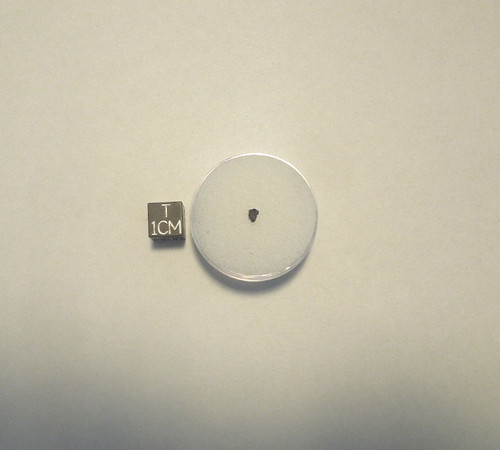On July 12th, 2017, a bright fireball streaked across the sky over the Tata region of Morocco. The fireball exploded and witnesses in the area reported hearing a series of sonic booms. After a subsequent search, several fresh meteorites were recovered. Some of the stones were analyzed and classified as LL5/6 chondrites that are mildly shocked at shock grade S3.
Refer to the photo. The black centimeter cube is shown for scale and is not included. You are purchasing a single small fragment like the one shown. Your purchase will include a labeled gemjar for safe storage.
From the Meteoritical Bulletin entry for Kheneg Ljouad :
Kheneg Ljouâd 28°59’03.3"N, 8°24’38.7"W
Guelmime Es Smara, Morocco
Probable fall: 2017 July 12
Classification: Ordinary chondrite (LL5/6)
History: (H. Chennaoui Aoudjehane, FSAC) On Wednesday, 12 July 2017, around 23:13 Summer Moroccan time (GMT+1,) a bright fireball was widely seen throughout southern Morocco, traveling from the NE to the SW, with termination of the fireball southwest of Tata. The fireball lasted for several " and was followed by a series of sonic booms heard throughout southern Morocco. This event was subsequently reported on the national TV news station). The authorities of the area including soldiers reported the fireball. The fall site is in a militarized area within Morocco, but close to the border with Algeria. Military and nomads where the first to arrive at the fall site and the first piece was found within 12 hours of the fireball, on 13 July. A field mission was organized by H. Chennaoui Aoudjehane (FSAC), M. Aoudjehane, A. Bouferra and H. El Harbi on Saturday, 15 July to collect the fall information and samples for classification and the submission. The team were granted authorization to enter the militarized area, and on 16 July traveled to the fall site. The team meet several hunters with fresh, black, fusion crusted stones. The largest complete piece that they have seen was about 850 g. Coordinates for three smaller stones are a complete 15 g stone (28°59’03.3"N, 8°24’38.7"W) and two pieces totalling 22 g (28°57’28.3"N, 8°25’39.6"W), and a stone of ~1 g (28°59’55.1"N, 8°24’25.5"W). Total mass collected to date is near 10 kg.
Physical characteristics: Many fusion crusted stones ranging from <1 g to 1.2 kg. Fusion crust is matte black. Interior of the stones is largely whitish gray, with a few thin shock veins, and studded with pods (to 1 cm) and veinlets of troilite.
Petrography: (L. Garvie, ASU) Optical and SEM imaging of a polished mount shows range of chondrule types, though largely recrystallized and integrated with the matrix, the chondrules still recognizable including a large BO (to 5 mm), PO and PP. Feldspar shows a range of sizes, some grains to 200 μm, though majority <50 μm. Metal and troilite heterogeneously distributed across the mount, largest grains to 100 μm. Metal dominated by tetrataenite, with only two small (20 μm) grains of kamacite found. Metallic Cu rare, as three grains (~5 μm) found at tetrataenite/troilite boundary. Metal+troilite occupy <2 vol% of the section. Troilite single crystal with rare twin lamellae. Pentlandite, <20 μm, is rare occurring as subhedral grains within troilite. Chromite is common as large, to 200 μm, anhedral grains and small, <5 μm, subhedral and euhedral grains in feldspar. A few small melt pockets observed in the mount are consistent with shock stage S3 .





